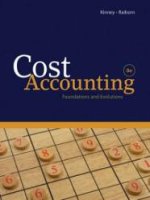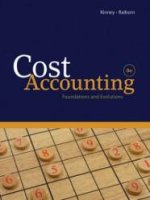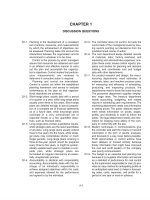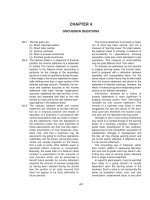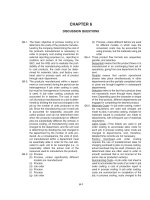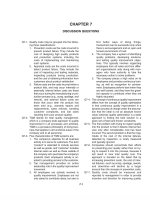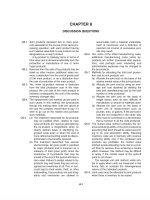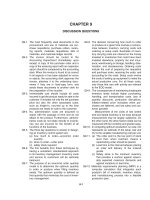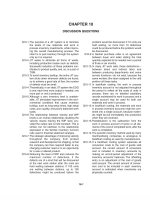Solution manual cost accounting 9th by kinney rainborn ch03
Bạn đang xem bản rút gọn của tài liệu. Xem và tải ngay bản đầy đủ của tài liệu tại đây (212.14 KB, 17 trang )
CHAPTER
3
PREDETERMINED OVERHEAD RATES,
FLEXIBLE BUDGETS, AND ABSORPTION/
VARIABLE COSTING
Learning Objectives
After reading and studying Chapter 3, you should be able to answer the following questions:
1.
Why and how are overhead costs allocated to products and services?
2.
What causes underapplied or overapplied overhead and how is it treated at the end of a period?
3.
What impact do different capacity measures have on setting predetermined overhead rates?
4.
How is the high-low method used in analyzing mixed costs?
5.
How do managers use flexible budgets to set predetermined overhead rates?
6.
How do absorption and variable costing differ?
7.
How do changes in sales or production levels affect net income computed under absorption and
variable costing?
8.
(Appendix) How is least squares regression used in analyzing mixed costs?
©2013 Cengage Learning. All Rights Reserved. May not be scanned, copied or duplicated, or posted to a
publicly accessible website, in whole or in part.
Chapter 03: Predetermined Overhead Rates, Flexible Budgets, & Absorption/Variable Costing
IM 2
Terminology
Absorption costing: A cost accumulation and reporting method that treats the costs of all manufacturing
components (direct material, direct labor, variable overhead, and fixed overhead) as inventoriable or
product costs in accordance with generally accepted accounting principles
Applied overhead: The dollar amount of overhead assigned from an overhead account to Work in
Process Inventory using the activity measure that was selected to develop the activity rate
Contribution margin: The difference between total revenues and total variable expenses (manufacturing
and non-manufacturing) computed on either a total or per unit basis; the contribution margin indicates the
dollar amount available to “contribute” to cover total fixed expenses, both manufacturing and
nonmanufacturing
Dependent variable: An unknown variable that is to be predicted using one or more independent
variables
Direct costing: See variable costing
Expected capacity: A short-run concept that represents the anticipated level of capacity to be used by a
firm in the upcoming period, based on projected product demand
Flexible budget: A planning document that presents expected variable and fixed overhead costs at
different activity levels
Full costing: See absorption costing
Functional classification: A group of costs that were all incurred for the same principle purpose (e.g.,
cost of goods sold, selling expenses, and administrative expenses)
High-low method: A technique that determines the fixed and variable portions of a mixed cost using only
the highest and lowest levels of activity within the relevant range
Independent variable: A variable that, when changed, will cause consistent, observable changes in
another variable; a variable used as the basis of predicting the value of a dependent variable
Least squares regression analysis: A statistical technique that analyzes the relationship between
independent (causal) and dependent (effect) variables in order to develop an equation that can be used
to predict the dependent variable; the method determines the line of “best fit” for a set of observations by
minimizing the sum of the squares of the vertical deviations between actual points and the regression
line; the method is used to determine the fixed and variable portions of a mixed cost
Multiple regression: A statistical technique that uses two or more independent variables to predict a
dependent variable
Normal capacity: The long-run (5–10 years) average production or service volume of a firm; normal
capacity represents an attainable level of activity since it takes into consideration cyclical and seasonal
fluctuations; normal capacity is required by generally accepted accounting principles
Normal costing: An alternative to actual costing, this costing system assigns to WIP Inventory the actual
costs of direct material and direct labor but an estimated amount of manufacturing overhead
Outlier: Abnormal or non-repres����������������������������������������������������������������������������������������������������������������������������������������������������������������������������������������������������������������������������������������������������������������������������������������������������������������������������������������������������������������������������������������������������������������������������������������������������������������������������������������������������������������������������������������������������������������������������������������������������������������������������������������������������������������������������������������������������������������������������������������������������������������������������������������������������������������������������������������������������������������������������������������������������������������������������������������������������������������������������������������������������������������������������������������������������������������������������������������������������������������������������������������������������������������������������������������������������������������������������������������������������������������������������������������������������������������������������������������������������������������������������������������������������������������������������������������������������������������������������������������������������������������������������������������������������������������������������������������������������������������������������������������������������������������������������������������������������������������������������������������������������������������������������������������������������������������������������������������������������������������������������������������������������������������������������������������������������������������������������������������������������������������������������������������������������������������������������������������������������������������������������������������������������������������������������������������������������������������������������������������������������������������������������������������������������������������������������������������������������������������������������������������������������������������������������������������������������������������������������������������������������������������������������������������������������������������������������������������������������������������������������������������������������������������������������������������������������������������������������������������������������������������������������������������������������������������������������������������������������������������������������������������������������������������������������������������������������������������������������������������������������������������������������������������������������������������������������������������������������������������������������������������������������������������������������������������������������������������������������������������������������������������������������������������������������������������������������������������������������������������������������������������������������������������������������������������������������������������������������������������������������������������������������������������������������������������������������������������������������������������������������������������������������������������������������������������������������������������������������������������������������������������������������������������������������������������������������������������������������������������������������������������������������������������������������������������������������������������������������������������������������������������������������������������������������������������������������������������������������������������������������������������������������������������������������������������������������������������������������������������������������������������������������������������������������������������������������������������������������������������������������������������������������������������������������������������������������������������������������������������������������������������������������������������������������������������������������������������������������������������������������������������������������������������������������������������������������������������������������������������������������������������������������������������������������������������������������������������������������������������������������������������������������������������������������������������������������������������������������������������������������������������������������������������������������������������������������������������������������������������������������������������������������������������������������������������������������������������������������������������������������������������������������������������������������������������������������������������������������������������������������������������������������������������������������������������������������������������������������������������������������������������������������������������������������������������������������������������������������������������������������������������������������������������������������������������������������������������������������������������������������������������������������������������������������������������������������������������������������������������������������������������������������������������������������������������������������������������������������������������������������������������������������������������������������������������������������������������������������������������������������������������������������������������������������������������������������������������������������������������������������������������������������������������������������������������������������������������������������������������������������������������������������������������������������������������������������������������������������������������������������������������������������������������������������������������������������������������������������������������������������������������������������������������������������������������������������������������������������������������������������������������������������������������������������������������������������������������������������������������������������������������������������������������������������������������������������������������������������������������������������������������������������������������������������������������������������������������������������������������������������������������������������������������������������������������������������������������������������������������������������������������������������������������������������������������������������������������������������������������������������������������������������������������������������������������������������������������������������������������������������������������������������������������������������������������������������������������������������������������������������������������������������������������������������������������������������������������������������������������������������������������������������������������������������������������������������������������������������������������������������������������������������������������������������������������������������������������������������������������������������������������������������������������������������������������������������������������������������������������������������������������������������������������������������������������������������������������������������������������������������������������������������������������������������������������������������������������������������������������������������������������������������������������������������������������������������������������������������������������������������������������������������������������������������������������������������������������������������������������������������������������������������������������������������������������������������������������������������������������������������������������������������������������������������������������������������������������������������������������������������������������������������������������������������������������������������������������������������������������������������������������������������������������������������������������������������������������������������������������������������������������������������������������������������������������������������������������������������������������������������������������������������������������������������������������������������������������������������������������������������������������������������������������������������������������������������������������������������������������������������������������������������������������������������������������������������������������������������������������������������������������������������������������������������������������������������������������������������������������������������������������������������������������������������������������������������������������������������������������������������������������������������������������������������������������������������������������������������������������������������������������������������������������������������������������������������������������������������������������������������������������������������������������������������������������������������������������������������������������������������������������������������������������������������������������������������������������������������������������������������������������������������������������������������������������������������������������������������������������������������������������������������������������������������������������������������������������������������������������������������������������������������������������������������������������������������������������������������������������������������������������������������������������������������������������������������������������������������������������������������������������������������������������������������������������������������������������������������������������������������������������������������������������������������������������������������������������������������������������������������������������������������������������������������������������������������������������������������������������������������������������������������������������������������������������������������������������������������������������������������������������������������������������������������������������������������������������������������������������������������������������������������������������������������������������������������������������������������������������������������������������������������������������������������������������������������������������������������������������������������������������������������������������������������������������������������������������������������������������������������������������������������������������������������������������������������������������������������������������������������������������������������������������������������������������������������������������������������������������������������������������������������������������������������������������������������������������������������������������������������������������������������������������������������������������������������������������������������������������������������������������������������������������������������������������������������������������������������������������������������������������������������������������������������������������������������������������������������������������������������������������������������������������������������������������������������������������������������������������������������������������������������������������������������������������������������������������������������������������������������������������������������������������������������������������������������������������������������������������������������������������������������������������������������������������������������������������������������������������������������������������������������������������������������������������������������������������������������������������������������������������������������������������������������������������������������������������������������������������������������������������������������������������������������������������������������������������������������������������������������������������������������������������������������������������������������������������������������������������������������������������������������������������������������������������������������������������������������������������������������������������������������������������������������������������������������������������������������������������������������������������������������������������������������������������������������������������������������������������������������������������������������������������������������������������������������������������������������������������������������������������������������������������������������������������������������������������������������������������������������������������������������������������������������������������������������������������������������������������������������������������������������������������������������������������������������������������������������������������������������������������������������������������������������������������������������������������������������������������������������������������������������������������������������������������������������������������������������������������������������������������������������������������������������������������������������������������������������������������������������������������������������������������������������������������������������������������������������������������������������������������������������������������������������������������������������������������������������������������������������������������������������������������������������������������������������������������������������������������������������������������������������������������������������������������������������������������������������������������������������������������������������������������������������������������������������������������������������������������������������������������������������������������������������������������������������������������������������������������������������������������������������������������������������������������������������������������������������������������������������������������������������������������������������������������������������������������������������������������������������������������������������������������������������������������������������������������������������������������������������������������������������������������������������������������������������������������������������������������������������������������������������������������������������������������������������������������������������������������������������������������������������������������������������������������������������������������������������������������������������������������������������������������������������������������������������������������������������������������������������������������������������������������������������������������������������������������������������������������������������������������������������������������������������������������������������������������������������������������������������������������������������������������������������������������������������������������������������������������������������������������������������������������������������������������������������������������������������������������������������������������������������������������������������������������������������������������������������������������������������������������������������������������������������������������������������������������������������������������������������������������������������������������������������������������������������������������������������������������������������������������������������������������������������������������������������������������������������������������������������������������������������������������������������������������������������������������������������������������������������������������������������������������������������������������������������������������������������������������������������������������������������������������������������������������������������������������������������������������������������������������������������������������������������������������������������������������������������������������������������������������������������������������������������������������������������������������������������������������������������������������������������������������������������������������������������������������������������������������������������������������������������������������������������������������������������������������������������������������������������������������������������������������������������������������������������������������������������������������������������������������������������������������������������������������������������������������������������������������������������������������������������������������������������������������������������������������������������������������������������������������������������������������������������������������������������������������������������������������������������������������������������������������������������������������������������������������������������������������������������������������������������������������������������������������������������������������������������������������������������������������������������������������������������������������������������������������������������������������������������������������������������������������������������������������������������������������������������������������������������������������������������������������������������������������������������������������������������������������������������������������������������������������������������������������������������������������������������������������������������������������������������������������������������������������������������������������������������������������������������������������������������������������������������������������������������������������������������������������������������������������������������������������������������������������������������������������������������������������������������������������������������������������������������������������������������������������������������������������������������������������������������������������������������������������������������������������������������������������������������������������������������������������������������������������������������������������������������������������������������������������������������������������������������������������������������������������������������������������������������������������������������������������������������������������������������������������������������������������������������������������������������������������������������������������������������������������������������������������������������������������������������������������������������������������������������������������������������������������������������������������������������������������������������������������������������������������������������������������������������������������������������������������������������������������������������������������������������������������������������������������������������������������������������������������������������������������������������������������������������������������������������������������������������������������������������������������������������������������������������������������������������������������������������������������������������������������������������������������������������������������������������������������������������������������������������������������������������������������������������������������������������������������������������������������������������������������������������������������������������������������������������������������������������������������������������������������������������������������������������������������������������������������������������������������������������������������������������������������������������������������������������������������������������������������������������������������������������������������������������������������������������������������������������������������������������������������������������������������������������������������������������������������������������������������������������������������������������������������������������������������������������������������������������������������������������������������������������������������������������������������������������������������������������������������������������������������������������������������������������������������������������������������������������������������������������������������������������������������������������������������������������������������������������������������������������������������������������������������������������������������������������������������������������������������������������������������������������������������������������������������������������������������������������������������������������������������������������������������������������������������������������������������������������������������������������������������������������������������������������������������������������������������������������������������������������������������������������������������������������������������������������������������������������������������������������������������������������������������������������������������������������������������������������������������������������������������������������������������������������������������������������������������������������������������������������������������������������������������������������������������������������������������������������������������������������������������������������������������������������������������������������������������������������������������������������������������������������������������������������������������������������������������������������������������������������������������������������������������������������������������������������������������������������������������������������������������������������������������������������������������������������������������������������������������������������������������������������������������������������������������������������������������������������������������������������������������������������������������������������������������������������������������������������������������������������������������������������������������������������������������������������������������������������������������������������������������������������������������������������������������������������������������������������������������������������������������������������������������������������������������������������������������������������������������������������������������������������������������������������������������������������������������������������������������������������������������������������������������������������������������������������������������������������������������������������������������������������������������������������������������������������������������������������������������������������������������������������������������������������������������������������������������������������������������������������������������������������������������������������������������������������������������������������������������������������������������������������������������������������������������������������������������������������������������������������������������������������������������������������������������������������������������������������������������������������������������������������������������������������������������������������������������������������������������������������������������������������������������������������������������������������������������������������������������������������������������������������������������������������������������������������������������������������������������������������������������������������������������������������������������������������������������������������������������������������������������������������������������������������������������������������������������������������������������������������������������������������������������������������������������������������������������������������������������������������������������������������������������������������������������������������������������������������������������������������������������������������������������������������������������������������������������������������������������������������������������������������������������������������������������������������������������������������������������������������������������������������������������������������������������������������������������������������������������������������������������������������������������������������������������������������������������������������������������������������������������������������������������������������������������������������������������������������������������������������������������������������������������������������������������������������������������������������������������������������������������������������������������������������������������������������������������������������������������������������������������������������������������������������������������������������������������������������������������������������������������������������������������������������������������������������������������������������������������������������������������������������������������������������������������������������������������������������������������������������������������������������������������������������������������������������������������������������������������������������������������������������������������������������������������������������������������������������������������������������������������������������������������������������������������������������������������������������������������������������������������������������������������������������������������������������������������������������������������������������������������������������������������������������������������������������������������������������������������������������������������������������������������������������������������������������������������������������������������������������������������������������������������������������������������������������������������������������������������������������������������������������������������������������������������������������������������������������������������������������������������������������������������������������������������������������������������������������������������������������������������������������������������������������������������������������������������������������������������������������������������������������������������������������������������������������������������������������������������������������������������������������������������������������������������������������������������������������������������������������������������������������������������������������������������������������������������������������������������������������������������������������������������������������������������������������������������������������������������������������������������������������������������������������������������������������������������������������������������������������������������������������������������ect statement concerning overapplied overhead.
a. The overhead control account will have a debit balance.
b. The amount of overhead transferred to WIP from the overhead control account exceeded the
actual amount of overhead incurred.
c. Overapplied overhead must be closed at year-end because a single year’s activity level was
used to set the predetermined overhead rate.
d. Overapplied overhead may result if the company’s actual utilization of capacity is greater than
expected.
4. (LO.3) In determining cost behavior in business, the cost function is often expressed as y = a +
bx. What does the “a” term represent?
a. Total variable costs
b. Total fixed costs
c. Unit variable cost
d. Unit fixed cost
5. (LO3) M Company derived the following cost equation to explain its monthly manufacturing
overhead cost:
OH = $80,000 + $12MH, where MH = machine hours
The standard time required to manufacture one unit is 4 machine hours. The company applies
manufacturing overhead to production on the basis of machine hours and its normal annual
production is 50,000 units. What is the estimated variable manufacturing overhead cost for a
month in which scheduled production is 5,000 units?
a. $360,000
b. $320,000
c. $240,000
d. $80,000
6. (LO.4 & LO.8) Which method of separating mixed costs ensures the best fitting regression line?
a. High-low method
b. Scattergraph method
c. Proration method
d. Least squares regression method
©2013 Cengage Learning. All Rights Reserved. May not be scanned, copied or duplicated, or posted to a
publicly accessible website, in whole or in part.
Chapter 03: Predetermined Overhead Rates, Flexible Budgets, & Absorption/Variable Costing IM 15
7. (LO.4) W Company is working on its annual profit plan for the coming year. The company wants
to determine the cost behavior pattern of its maintenance costs. The prior year’s data regarding
maintenance hours and costs are as follows.
January
February
March
April
May
June
July
August
September
October
November
December
Hours of
Activity
Maintenance
Costs
480
320
400
300
500
310
320
520
490
470
350
340
$ 4,200
3,000
3,600
2,820
4,350
2,960
3,030
4,470
4,260
4,050
3,300
3,160
Using the high-low method, estimate the amount of maintenance cost per hour.
a. $2,781
b. $570
c. $7.50
d. $0.13
8. (LO.8) X Company uses simple regression to separate its selling costs (y) into fixed and variable
components based on units sold (x). A computer software program generated the following
regression analysis results:
Average x
Average y
a
Standard error of a
b
Standard error of b
Std error of the estimate
2
r
400
3600
684.65
49.515
7.2884
0.12126
34.469
0.99724
What equation should X Company use to estimate its selling costs?
a. y = $3,600 + 400x
b. y = $684.65 + 7.2884x
c. y = $3,600 + 7.2884x
d. y = $684.65 + .12126x
9. (LO.5) In applying overhead, individual department rates would be used instead of a plant wide
rate if
a. the manufactured products differ in the resources consumed from the individual departments
in the plant.
b. a company wants to adopt a standard cost system.
c. a company’s manufacturing operations are highly automated.
d. manufacturing overhead is the largest component of product cost.
©2013 Cengage Learning. All Rights Reserved. May not be scanned, copied or duplicated, or posted to a
publicly accessible website, in whole or in part.
Chapter 03: Predetermined Overhead Rates, Flexible Budgets, & Absorption/Variable Costing IM 16
10. (LO.6) Which cost accumulation and reporting system treats the costs of all manufacturing
components (direct material, direct labor, and both variable and fixed overhead) as product
costs?
a. Absorption costing
b. Variable costing
c. Mixed costing
d. None of the above
11. (LO.6) Which cost accumulation and reporting system reports the total contribution margin?
a. Absorption costing
b. Variable costing
c. Mixed costing
d. None of the above
12. (LO.6) Which cost accumulation and reporting system is required for external reporting and tax
purposes?
a. Absorption costing
b. Variable costing
c. Mixed costing
d. None of the above
13. (LO.7) The primary difference between absorption and variable costing lies in the treatment of:
a. variable selling and administrative costs.
b. variable overhead costs.
c. fixed overhead costs.
d. fixed selling and administrative costs.
14. (LO.7) Which cost accumulation and reporting system provides management an incentive to
over-produce (i.e., produce more units than can be sold)?
a. Absorption costing
b. Variable costing
c. Mixed costing
d. None of the above
15. (LO.7) In a period in which there is no change in inventory, which cost accumulation and reporting
system will report higher profits?
a. Absorption costing
b. Variable costing
c. Mixed costing
d. None of the above
©2013 Cengage Learning. All Rights Reserved. May not be scanned, copied or duplicated, or posted to a
publicly accessible website, in whole or in part.
Chapter 03: Predetermined Overhead Rates, Flexible Budgets, & Absorption/Variable Costing IM 17
Multiple Choice Solutions
1.
b
2.
b
3.
a
4.
b
5.
c (CMA Adapted)
5,000 units × 4 machine hours per unit = 20,000 machine hours × $12 per machine hour =
$240,000 variable overhead
6.
d
7.
c (CMA Adapted)
Unit variable cost = ($4,470 - $2,820) / (520 – 300) = $7.50
8.
b (CMA Adapted)
9.
a (CMA Adapted)
10.
a
11.
b
12.
a
13.
c
14.
a
15.
d
©2013 Cengage Learning. All Rights Reserved. May not be scanned, copied or duplicated, or posted to a
publicly accessible website, in whole or in part.
